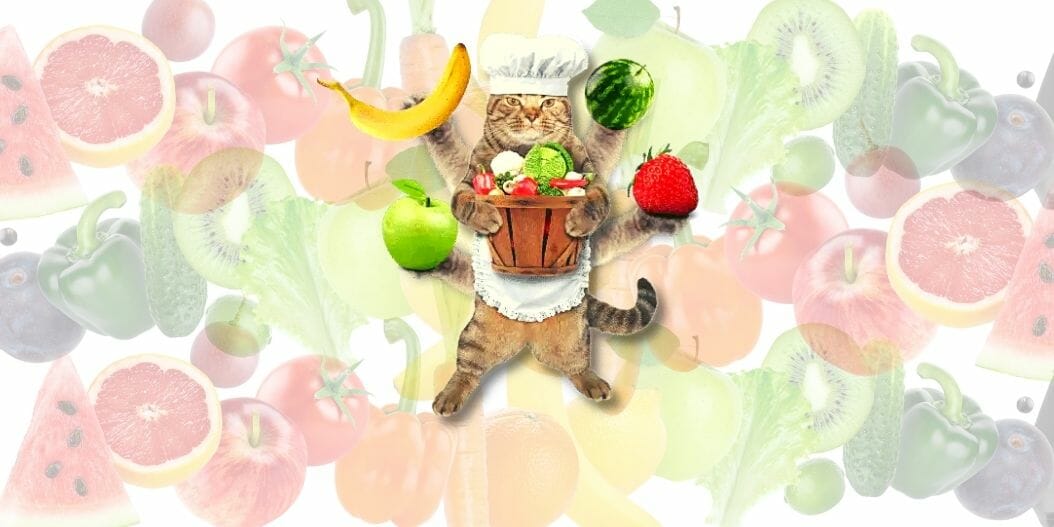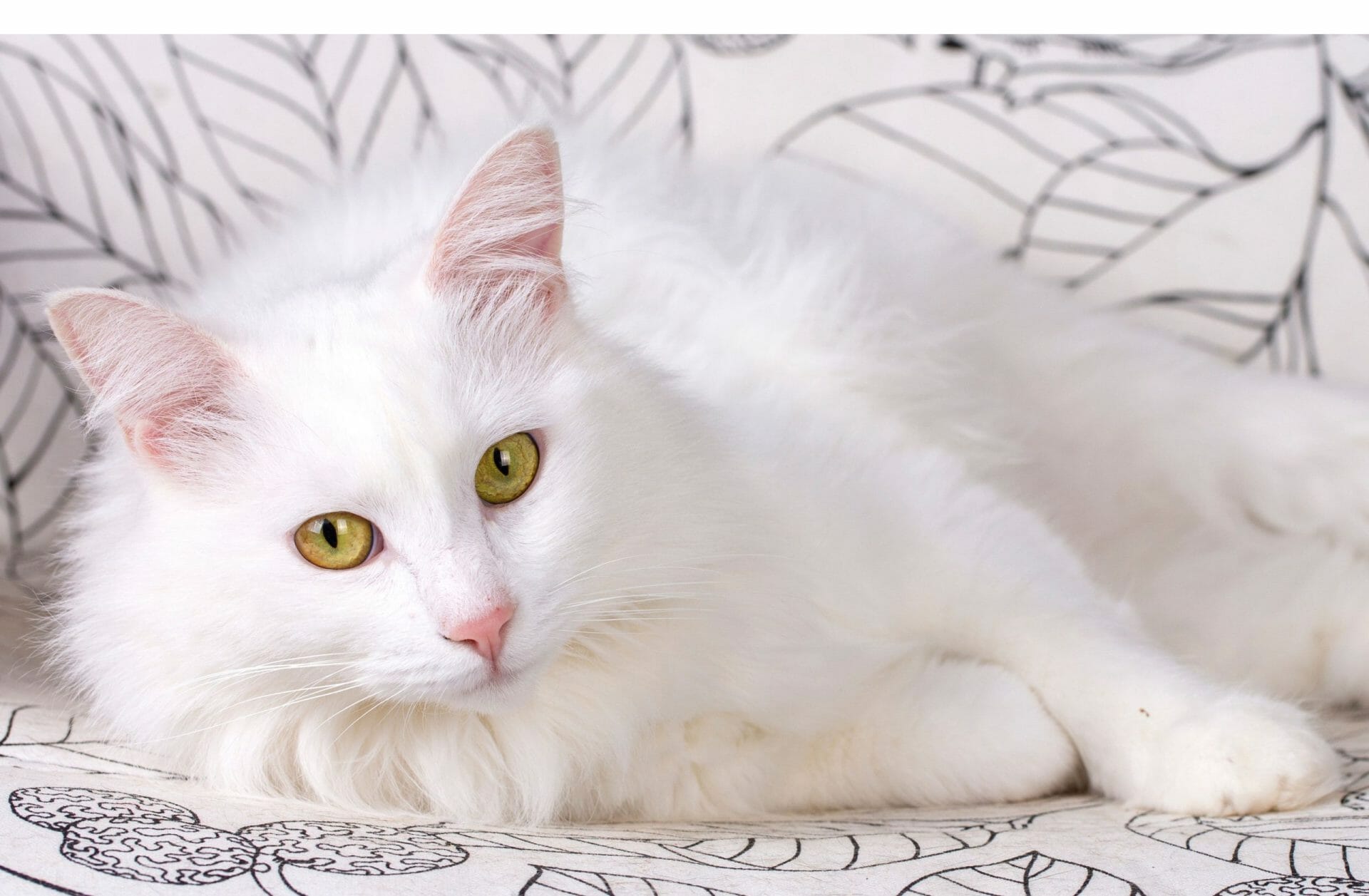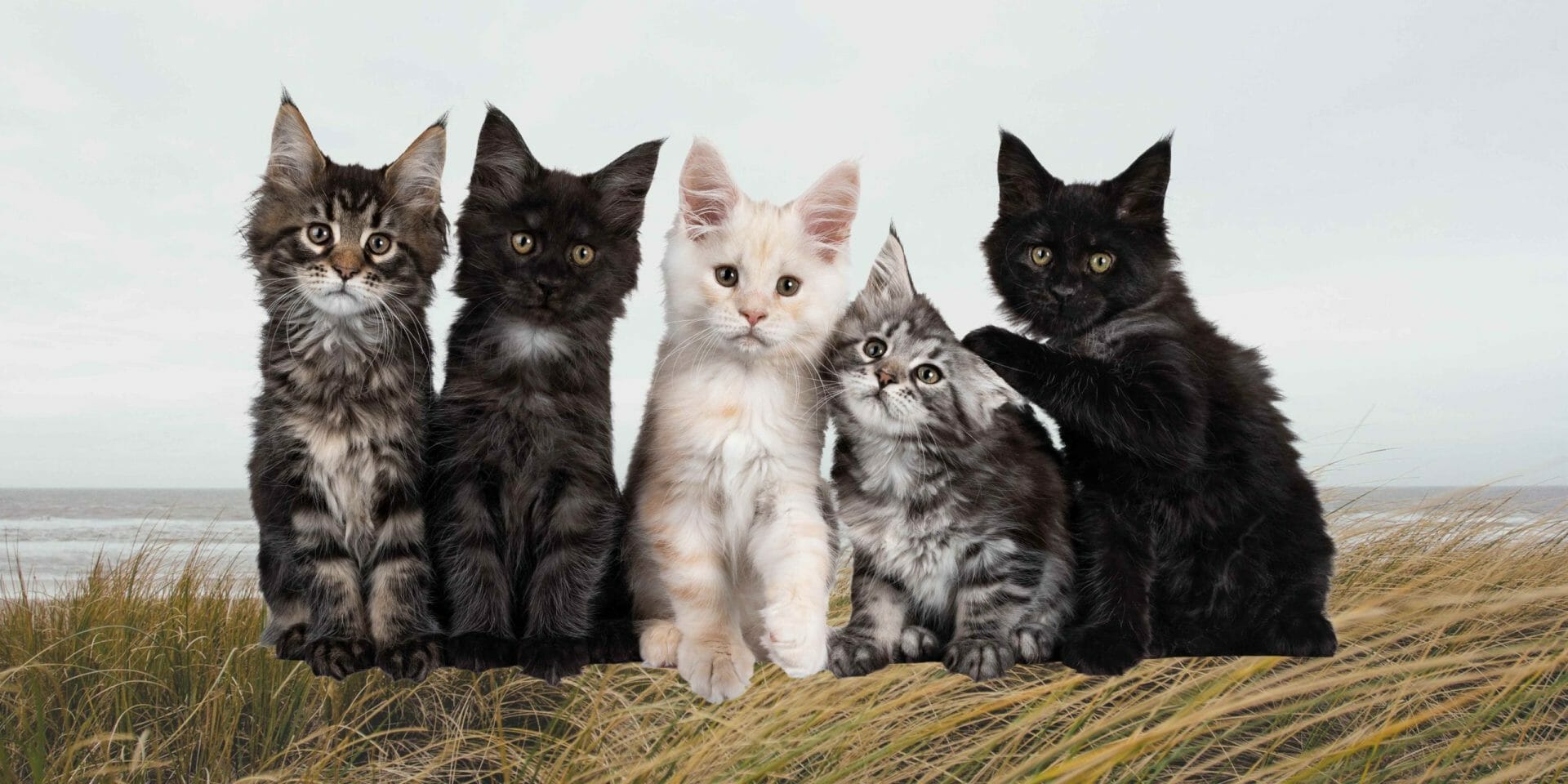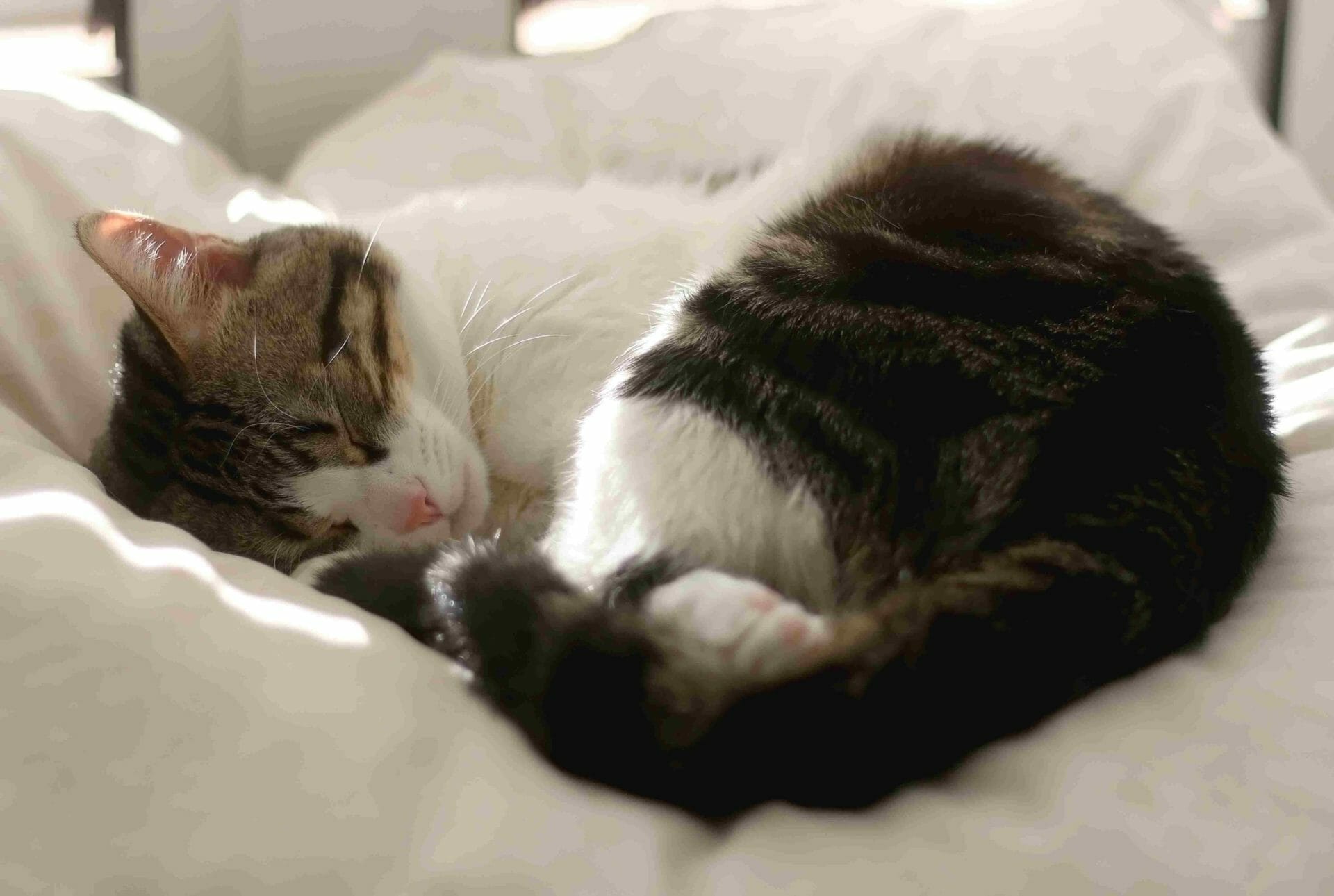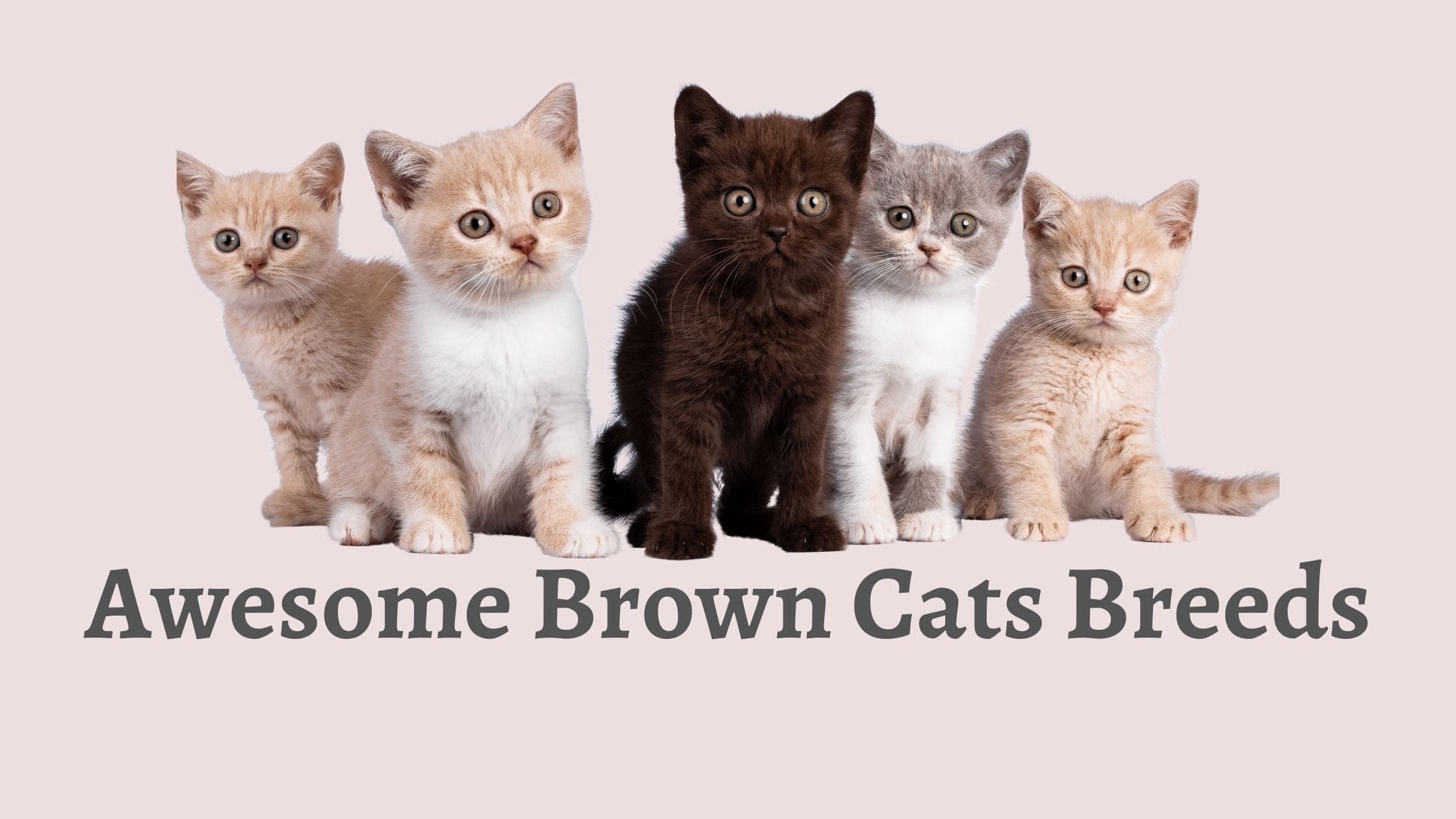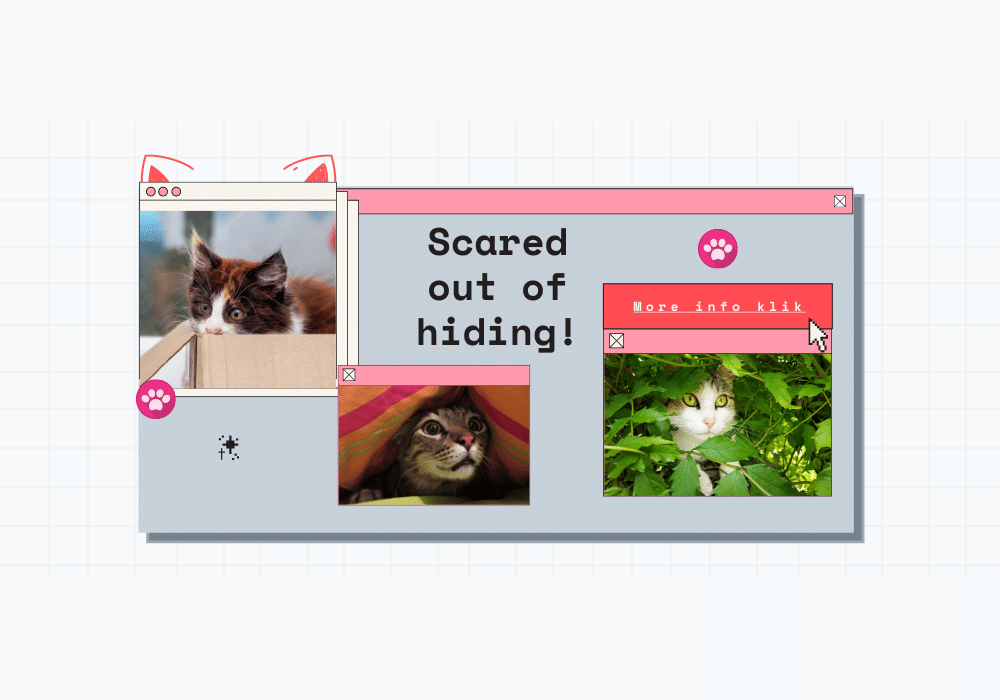35 Best Fruits and Vegetables For Your Cat (Master Guide)
Cats are genuine carnivore animals. Meat is a significant and main ingredient that they need in their diet. Cats can feed on fresh meat as a part of their balanced diet, which must be thoroughly cooked through and with all bones removed carefully so that not even a single piece is left to ensure prevention from obstruction of the digestive system. Also, bones may be stuck in their throat, or bones may damage their teeth.
But what if we talk about fruits—are fruits safe for cats? And if they’re safe, then which fruits can be eaten? Which fruits can cats digest easily?
Cats lack the sweet taste receptors of the tongue. Therefore the cats are usually not interested in the sweetness found in fruits. They are more interested in eating meat or any flesh. However, there are many kinds of fruits that cats might love to eat as a treat in moderation. A few bites are all that they can easily digest—feeding more than a certain amount can be dangerous for them as it can do more harm.
Fruits that cats can eat
Here we are going to state some beneficial fruits and their usefulness for cat’s well-being:
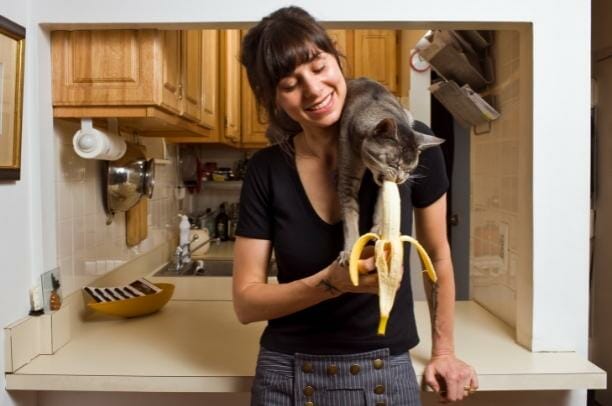
Bananas
Cats like to eat bananas. Rather, they love to eat bananas. As we all know, Bananas are an excellent source of vitamin B6 and vitamin C, potassium, and carbohydrates. We can offer sliced bananas to cats that can be either fresh or frozen bananas.
Watermelon

Cats can also eat a tiny portion of watermelon flesh occasionally. If someone’s cat eats a bit of rind or seeds, it can lead to bowel cleansing. You can not give your cat the skin or grains, and they can not digest them. Also, these can be harmful to their health. You can occasionally provide thin, pale seeds from a “seedless” watermelon that would not cause any harm if your cat accidentally ingests them.
Strawberries
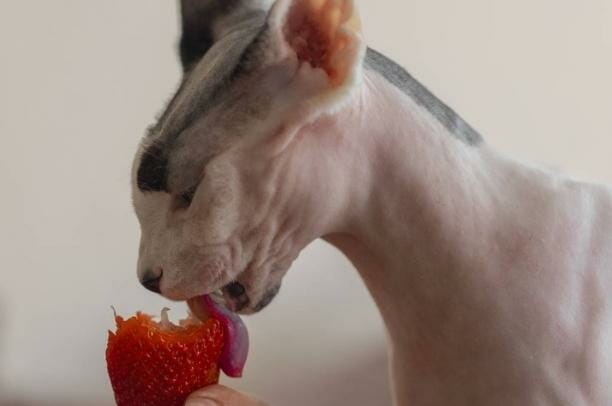
Everyone loves to eat strawberries, and so do the cats. Cats love to eat strawberries, but they can eat them in tiny amounts. Although strawberries are an excellent source of vitamin C, folate, potassium, manganese, antioxidants, and a rich source of fiber, these benefits are not much noticeable in cats because cats cannot safely consume large amounts. Also, they are not digestible in large quantities, so it instead causes more harm and can not be given to cats in large amounts. Always make sure to remove the stems and leaves from strawberries, wash them with water very well before cutting them into small pieces and then provide them to the cats in smaller amounts. Make sure that strawberries be cut into small pieces so that they may not cause any harm and be easily digested and consumed by the cats.
Blueberries, Raspberries, Cranberries, and Blackberries(i.e., berries)
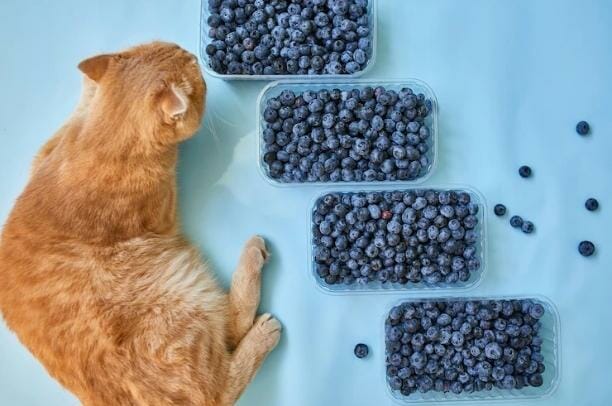
Blueberries, blackberries, raspberries, cranberries, and all other berries are all safe for cats to eat. They are all rich in antioxidants and flavonoids and high in fiber and vitamins such as vitamins A, C, K, and E. Cats can eat these and all other berries. Make sure that you cut each fruit into bite-sized portions before providing it to the cat to avoid choking hazards. Also, the bite-sized fruits can easily pass through their esophagus and are easy to digest as more enzymes can attack them.
Apples
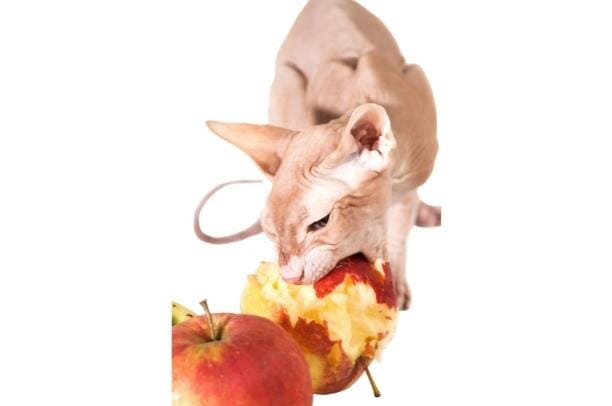
Cats can also eat apples. The flesh/peel of apples is rich in calcium, vitamin C, vitamin K, and pectin, and the skin is also rich in phytonutrients that are of high nutritious value for cats. Therefore cats can have the same health benefits from apples as humans do, and they are of equal significance for cats as they are to the human diet. To feed the cats, cut small slices or cubes with the flesh, peel off apples, or even the apple peel. The stems and the seeds must be avoided as they can disturb their digestive system and disturb their bowel movements.
Mangoes
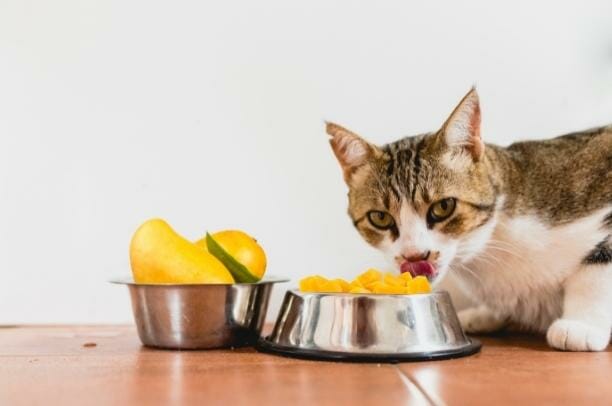
Mangoes are a sweet fruit, and these are something that can be a treat for cats as well as pet owners. Mangoes are rich in fiber, vitamin C, vitamin B6, and vitamin A. Mangoes can be provided in both ways. Always cut the cubes or slices of mango, peeled off or with flesh. Also, the meat is allowed, but avoid the skin and seed, as they can disturb their metabolism.
Pineapple
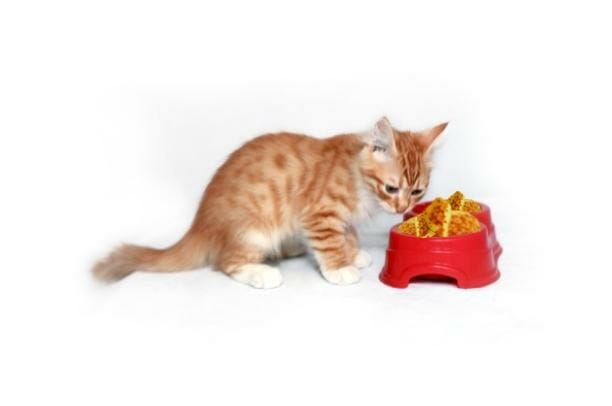
Cats can also eat pineapple, with just a few stipulations. This tropical treat is highly rich in fructose(keto-sugar, an isomer of glucose, fructose is the sweetest sugar in the world) and contains several vitamins (such as vitamin A, B6, folate, and C) and minerals (that may include magnesium and potassium). Therefore canned pineapple should be avoided. Fresh pineapple should be preferred over the canned one, usually packed in a sugary syrup containing several preservatives (these preservatives may cause some health hazards for cats). Permanently remove the leaves, thorns, and rind entirely before feeding your cat or sharing with your feline friend.
Cantaloupe
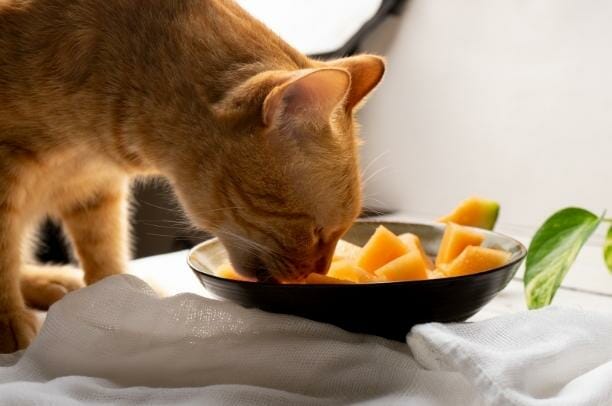
It is safe to feed cats with cantaloupe, which is a rich source of vitamin C, beta carotene, rich in fiber, and rich in antioxidants. This is a relatively low-calorie fruit, and it is often a favorite of felines because of the scent and aroma produced by the cantaloupes mimicking the smell of the proteins present in meat. One can offer small cubes or slices of the flesh (always cut slices or cubes before feeding it to your cat), but avoid the rind because it may be harmful to the cat’s gut and digestive system.
Fruit Snacks
Cats should not be given fruit snacks. Also, the cats should not be offered gummy snacks because these are prepared from fruit juice concentrate and do not contain fruit fiber. Some may have even more sugar than candy, making them incredibly unhealthy and hazardous for cats.
Amount of fruit a cat can have
Fruits can be best given as an alternative to cat treats, especially when weight loss for the cat is desired. They limit the fruits and other goodies to just about 2% of your cat’s diet. This can be approximately about 1-inch each day. Fruits may be offered as a fresh or frozen treat, but it is a must that the fruit is always cut into smaller pieces. Fruits should be given separately from the cat’s regular pet food.
Suppose someone’s cat cannot comfortably and easily digest the fruit, and the cat feels a disturbance in the digestive system. In that case, one may see signs of digestive upset (upset stomach), including vomiting, diarrhea, or constipation. Due to high sugar content, diabetic cats should not be fed fruit.

Other Fruits That Are Safe for Cats
Other fruits are also safe for cats to eat but in small quantities. Always make sure to remove the seeds, stems, pits/cores, and rinds:
- Apricots (roots, stems, holes must be avoided)
- Cucumber can be given without rind
- Honeydew is also good in small amounts
- Kiwi
- Nectarines may be given
- Pears (seeds, stems, and pets should be avoided)
Apricots
The bright orange-colored ripe apricot shows that these apricots are fully packed with beta-carotene, which is helpful for the cat’s body to fight against carcinogenic (cancer-causing) free radicals. Ensure to feed only the fresh apricots, not store and not dry. Always make sure that the cat does not have access to the pit/rind of the apricot or your cat does not eat leaves or stems of the tree because these can all be mildly poisonous and can do more harm.
Cranberries
Cranberries are very well famous and valuable for their ability to prevent urinary tract infections. These fruits also contain so much vitamin C and manganese and are rich in fiber. Cranberries can usually be seen in premium quality commercial cat food blends, so you can tell that these berries are suitable for cats. Some cats may enjoy the taste, although others can find them too tart.
Pears
Pears have great health significance for humans and are richly filled with fiber, vitamin A, and vitamin C (ascorbic acid). These have a relatively bland flavor that may appeal to some cats rather than more strongly flavored fruits. Pear seeds also contain a small amount of cyanide, so always carefully remove each origin before feeding your cat as they can be harmful. Remove the skin and the core before providing for your cat to avoid any harmful effects.
Raspberries
Raspberries contain a sufficient amount of vitamin C and plenty of fiber. However, they are low in sugar quantity. Raspberries also show some mild anti-inflammatory effects that can be useful for treating inflammation and painful joints in older pets with stiff joints. Raspberries also contain a sufficient amount of xylitol. It is the same sweetening substance used in some brands that produce chewing gum and peanut butter. In vast quantities, xylitol can be fatal to cats, so only feed the raspberries in tiny amounts, wash them properly, and cut them into small cubes or slices.
Importance of fruits in a cat’s diet
Cat owners often think of a question: what is the significance of feeding our cats with fruits such as bananas, oranges, mangoes, and all other fruits they can eat? As cats are already carnivores, why do we need to feed them with fruits?
Whether you are trying to slim down your cat’s waistline or are just looking for healthy and easily digestible food alternatives for commercial pet treats to feed your cat, there is something significant you can provide to your cat to make its life healthier and happier, also to make its stomach very well. Many fruits we (humans; cat owners) eat can also be given to our cats. However, some fruits can also be potentially dangerous and must be avoided entirely.
Adding fruits to cat’s diet:
Fruits into your cat’s diet may cause stomach issues or gut upsets such as vomiting or diarrhea. Be careful to introduce only one new fruit at a time to help you spot any health changes so that you may correct them before it causes harm to your cat.
Steer clear of:
Cherries are toxic for cats, and grapes and raisins can lead to kidney damage. Citrus fruits like lemons, limes, grapefruit, and persimmons may cause an upset stomach or stomach issues.
All the following fruits are safe for your cats to eat. Generally, fruits are higher in sugar content, and thus fruits should be limited for overweight pets so that they may not put on more weight. However, always wash all fruits properly with water and remove rinds, inedible skins, seeds, and pits before feeding fruits to your cat. Also, make sure to cut fruits into small cubes or thin slices to make them easily digestible for your cat.
Cats should not be given grapes or raisins because they may lead to kidney failure. Citrus fruits are also toxic to cats and can cause stomach upset or gastric issues.
| Kitten Age | Meals Per Day | Dry Food Per Meal | Wet Food Per Meal |
| 8 – 12 weeks | 4 | 5 – 7 g | 35 – 50 g |
| 3 – 6 Months | 3 | 6 – 8 g | 60 – 70 g |
| 6 – 12 months | 2 | 12 – 17 g | 90 – 110 g |
Vegetables
Many people think that asking for vegetables and food at the dinner table is an attitude that only dogs exhibit. Still, it’s widespread behavior for your feline to beg for vegetables! If some cat owner is tucking into a tasty tuna sandwich or enjoying a bowl of ice cream, their cat will likely be expecting them to slip a tasty morsel their way too. But it’s essential to know that just because food is OK for us to eat does not mean that it automatically makes it OK for them too.
Humans can eat many vegetables and fruits, whereas while feeding an animal, especially cats, it is essential to know what you are giving them to avoid any unpleasant event. We can provide our cats with certain vegetables but in small amounts. Also, some vegetables can not be fed to cats even in a small amount, so care should always be practiced while feeding your pets, especially your cats.
Generally, your cat should be fed everything they need from a 100% complete and balanced diet to ensure a healthy lifestyle. There’s no need to add plenty of extra ingredients to your pets’ food chart, but there are certain human foods you should give them as an occasional treat that helps maintain a balanced and healthy diet.

It is common for cats to hate vegetables, so they may simply turn their nose away or up when presented with vegetables. However, if your feline enjoys an odd vegetable snack, they offer a great source of many vitamins, rich in fiber and water. Some vegetables that may be safe for the cats to eat include cucumber, steamed broccoli, carrots and asparagus, and peas.
Unlike humans, cats are not omnivores; cats are carnivores. Cats have to get their primary nutrition from a carnivorous diet, including fish, chicken, turkey, and other meats. The feline organism has some special dietary requirements met through the protein diet, vitamins, and other nutritional ingredients found in the heart and flesh.
Premium quality cat food manufacturers praise and advertise their products as containing high amounts of real meat and fillers at a very little or no charge, such as wheat, rice, and other grain crops.
Even though feline furballs are carnivorous animals by default, they may still need vitamins for various functions, just like humans. A well-balanced human diet includes a lot of vegetables and fruits. Many domestic kitties won’t mind sharing their owner’s veggie or fruit-based snacks, even though they don’t contain meat.
Is there any benefit to cats from eating vegetables?
Many cat foods and treats offer many different vegetables in their recipe formulas and diet charts. Vegetables are rich in healthy ingredients, including potassium, riboflavin, antioxidants, dietary fiber, and vitamins. These ingredients are essential for cats of all breeds, no matter which age group the cats belong to.
1. Broccoli
Broccoli is one of the most popular vegetables used by humans. But do you know that it is also one of the best superfoods for cats?
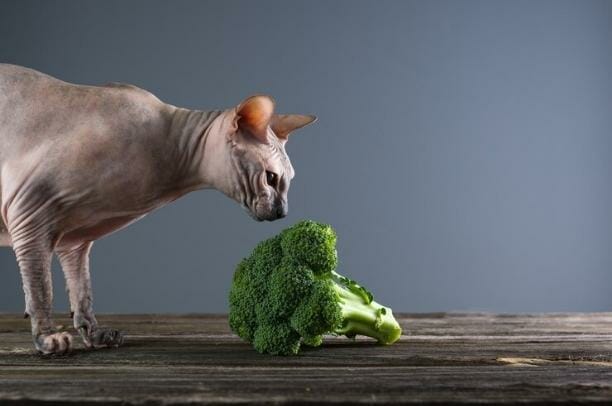
Broccoli is a superfood for felines and is suitable for many reasons. Broccoli florets are rich in antioxidants and contain plenty of dietary fiber. Constipated kitties or cats with digestive system disturbances may benefit from additional use of threads. And on top of that, the abundance of antioxidants in broccoli will also be helpful for every single furball out there.
Your fluffy cat may safely munch on some steamed broccoli florets mixed in the typical cat’s diet. There is one downside to too much broccoli, though – too much of its fiber can cause diarrhea.
2. Carrots
Feline teeth are pretty different from rabbit teeth, but this does not mean cats will not benefit from eating this particular bunny food. You might be surprised, but carrots may also be considered a superfood for cats due to their health benefits.
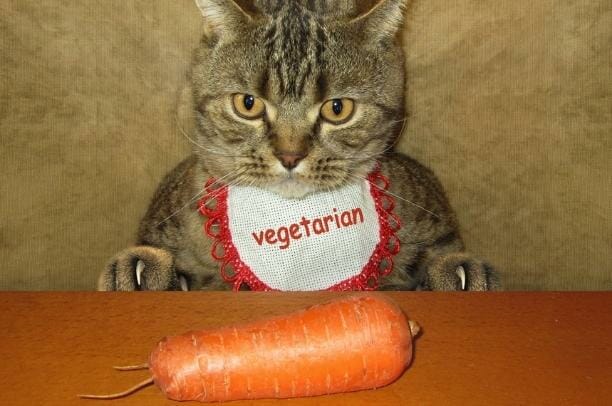
Carrots have low-fat content, making them an excellent snack for overweight cats. There is something more carrots offer: potassium, calcium, dietary fibers, vitamins A, C (ascorbic acid), and B6. Moreover, this vegetable is an excellent source of beta-carotene.
You may not know this, but many cat food manufacturers use carrots in their snacks and many more recipes. Since the feline organism can’t process and digest this veggie like the human organism, it is not easy for them to digest carrots. One should feed only moderate or tiny and properly cut amounts of carrots to their furry companion. The best way is to offer grated or finely chopped carrots that must be adequately washed before feeding, and then they’re cooked properly. This will make them easier for digestion, and it will also prevent the cat from choking with larger chunks. Also, it may not present many health hazards.
3. Peas
Green peas are among the top healthiest and easy-to-digest vegetables for humans and cats alike. If you don’t believe us, you can do quick research on the ingredients in premium quality cat foods – that may be either canned or in the form of kibble. You’ll find that peas are one of the most popularly used veggie ingredients in premium quality cat foods and snacks.
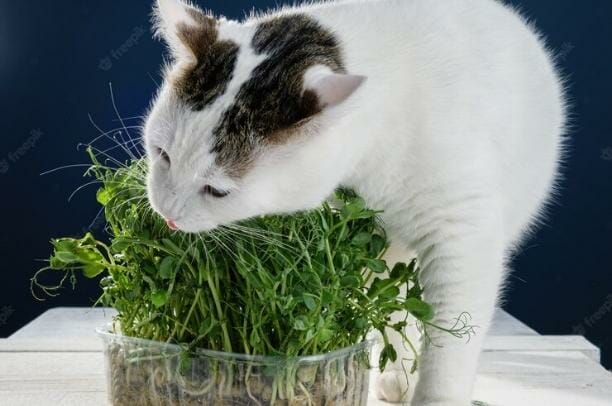
Magnesium, calcium, iron, manganese, zinc, potassium, copper, and phosphorus are some of the most beneficial and essential nutrients found in green peas. They also contain plentiful amounts of vitamins A, K, B1, B2, B6, and C, significant for humans and cats. Mixing some steamed peas in your cat’s food will add some carbohydrates and protein to its diet. There may be other ways to offer green peas to your pet. One of them is to puree them before serving them.
4. Beans
One of the best vegetables for cats, significantly overweight cats, is green beans. These are 100% safe for the feline organism, and there is plenty of dietary fiber and protein present in green.

Cooked green beans can be served as a healthy substitute for traditional cat treats. Green beans are rich in thiamine, riboflavin, calcium, magnesium, potassium, and vitamins A, B6, C, and K. The cooked beans are unseasoned and do not contain any preservatives don’t have any dressings. They are perfectly safe for your kitty. Like peas, one can serve them whole or pureed, but only in moderate amounts according to your cat’s weight.
5. Zucchini
According to the statistics and information from ASPCA, zucchinis are non-toxic to cats. What ASPCA does not say, however, is that this particular vegetable (zucchini) is one of the best weight loss foods to give to an obese cat/furball.
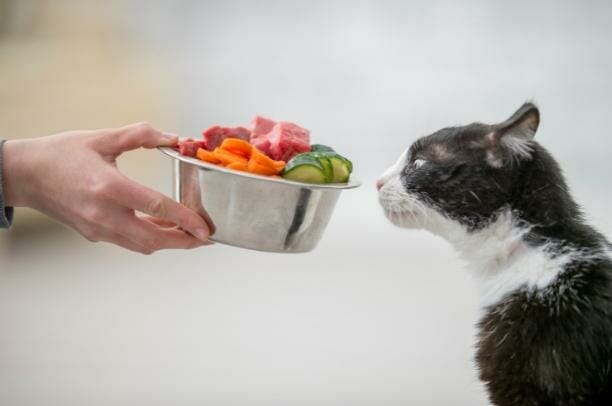
Diabetic or overweight cats can benefit from eating zucchinis because they are relatively low on calories. On the other hand, zucchini contains high amounts of vitamins C, A, and B6 and minerals such as magnesium, iron, calcium, potassium, and dietary fiber. Finely chopped and steamed zucchinis may easily be hidden inside a wet canned cat food bowl. If your feline pal is too demanding, you can chop the zucchini into a fine puree before mixing it with the food.
6. Spinach
Another famous human superfood may also be beneficial to cats – spinach. Spinach contains many vitamins and minerals, significant for every living organism, including cats. One of its best advantages is that spinach can serve as an anti-inflammatory diet for the cat’s digestive tract lining, helping to relieve any kind of inflammation.
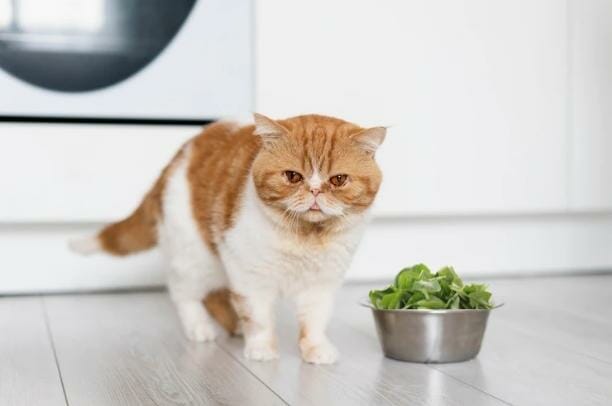
Spinach, like other green leafy vegetables, contains calcium oxalate. Even though the amounts of calcium oxalate in spinach are relatively low, they can contribute to the possible formation of harmful crystals or stones in your cat’s urinary tract. However, spinach may also be dangerous to some cats, especially those suffering from urinary tract problems such as infections, etc.
Regardless of the kind of vegetables, you will provide to your cat, always keep in mind one thing: the kitty is a carnivore. A well-balanced and measured cat/pet diet features
real meat or flesh in a balanced amount as a primary food item. In contrast, vegetables must be fed to the cats but only as a bonus in balanced amounts keeping all the serving conditions in mind. Veggies can’t substitute the essential ingredients in actual meat products. And if your cat is thriving on a vegetable-based diet, it may suffer from weakness and malnourishment, leading to several health problems.
7. Potato
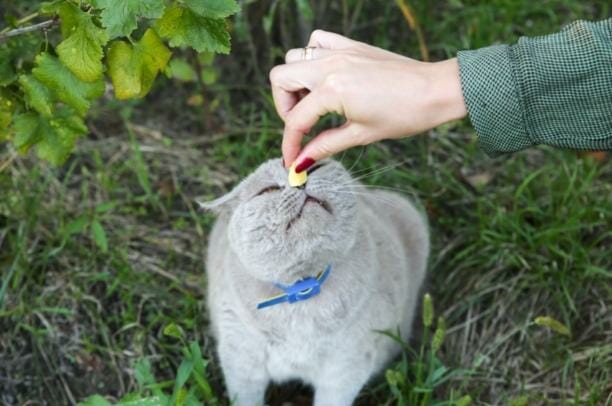
Some cat owners ask a question: can they feed potatoes to their cats? Sure, if potatoes are served without the skin and in moderate quantities. Cooked potatoes may be used in some cat food to provide grain-free and gluten-free carbohydrates as a supplement added to the meat in its ingredients. As long as potatoes are cooked well, cats usually do not face any problem digesting potatoes. Mashed potatoes are not so great for cats when it comes to mashed potatoes. Such recipes typically include cheese, butter, and milk, making them unwanted and inedible for a proper cat’s diet. Always remember that you should never feed cats raw potatoes or potato skins. It’s dangerous for cats as it contains solanine, a chemical that can be toxic, even poisonous, and can damage your cat’s nervous system and digestion. The leaves and stems also contain toxic compounds, so remember to keep them away from your kitties.
8. Lettuce
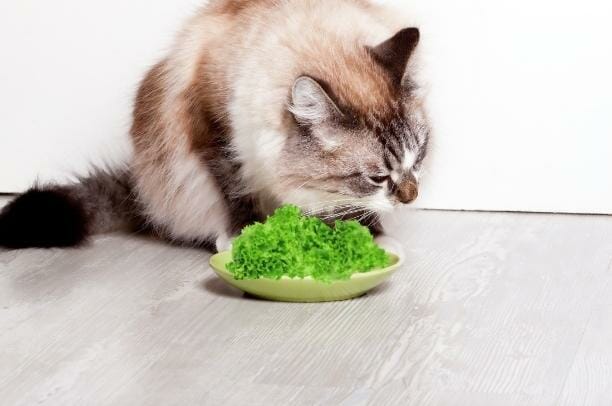
When we talk about lettuce, it has high water content, making it a good option for cats who have some issues getting hydrated. Another benefit of giving lettuce to your cat is that lettuce relatively contains fewer calories, so one won’t have to worry about their cat gaining much weight if they have it as a snack. Lettuce is also rich in fiber, which can help your cat in the poop department.
Other vegetables that can be fed to your cats in small amounts:
- Garlic (better provided in the chopped form)
- Celery
- Cauliflower
- Asparagus
- Kale
- Ginger
- Onions (it may be acidic in high quantities, so onions must be fed in small amounts so that they may not be proved to be caustic or toxic for them)
- Sweet potatoes (potatoes contain a high amount of carbohydrates, so they are dangerous for overweight cats, for them, these should be avoided)
- Parsley
Herbs can also be fed such as:
- Rosemary
- Thyme
- Basil (in fewer amounts)
- Mint
- Cilantro (always keep the quantities balanced)
- Lemongrass and others.
These all, whenever fed, should always be given in small amounts, keeping everything balanced.
Cat owners should always follow a proper diet plan to keep their kittens healthy and happy. Vegetables and fruits are essential for a cat’s diet. We can not avoid fruits and vegetables. Therefore, vegetables and fruits are a must, whether fed as snacks or treats. But always follow a proper diet plan recommended by veterinarians so that your cat may not face any gut or stomach disorders.
Fruit and vegetables are significant components in cats’ diets. In addition to plenty of vitamins and minerals, they supply a high quantity of essential fiber, which helps promote healthy gastrointestinal function, prevents stomach disorders, and supports the immune system. Funny pictures of cats biting greedily into melons are widespread. This indicates their love for fruits and vegetables. Also, their dietary requirements are characterized by such images.
Vegetables come in most dry and wet food varieties. In most premium quality food products made for cats, you will find potatoes, peas or red lentils, and other vegetables or fruits. If someone’s pet is on a BARF diet, they should make sure fruit and vegetables must be on the menu to ensure that all the nutritional needs are met. Whatever your cat’s essential diet looks like, they will enjoy a piece of fruit or a vegetable snack.
A rough rule is that vegetables that humans can only eat when cooked and can not eat in their natural form should also not be offered raw to cats. To make sure your cat can digest the vegetables properly, you can puree or gently steam them first, mash them, or cut them into small cubes or thin slices. But a few kinds of fruit and vegetables can also be offered raw as those are not harmful that way.
Not all pets can bear different kinds of fruit and vegetables equally well. In addition to choosing between varieties, it is significant to get the quantity right to maintain a balanced diet. Ideally, one should only offer snacks in this form in small amounts and take a cautious approach.
Feeding Guidelines
| Weight of Cat | 5 Lb | 10 Lb | 15 Lb |
| Adult Maintenance (Cups per day*) | 3⁄8 | 1⁄2 | 3⁄4 |
| Weight loss (Cups per day*) | 1⁄4 | 3⁄8 | 1⁄2 |
*Standard 8 oz dry measuring cup.
Always follow diet guidelines according to your cat’s age and breed.
Related Posts
- What Causes Dogs to Scratch Their Bedding Before They Go To Sleep?
- 35 Best Fruits and Vegetables For Your Cat (Master Guide)
- What Breed Of Dog Does The US Secret Service Exclusively Use?
- Can a Dog Eat Popcorn? (Everything You Need To Know)
- Why Does My Cat Lick My Hair?
- How Much Chocolate Can Kill a Dog? (Easy Guide)
- 23+ Best White and Black Cat Breeds You Should Know
- Why Does My Dog Smell Like Fish?
- 25 Fastest Dog Breeds in The World
- 22+ Best Grey Cat Breeds You Should Know
